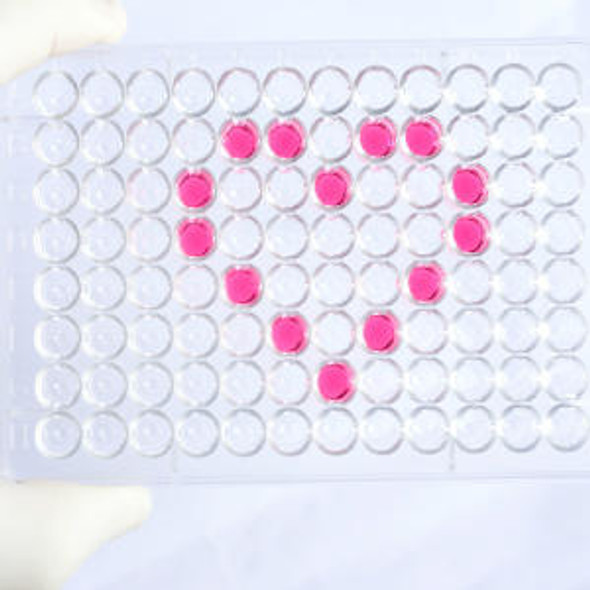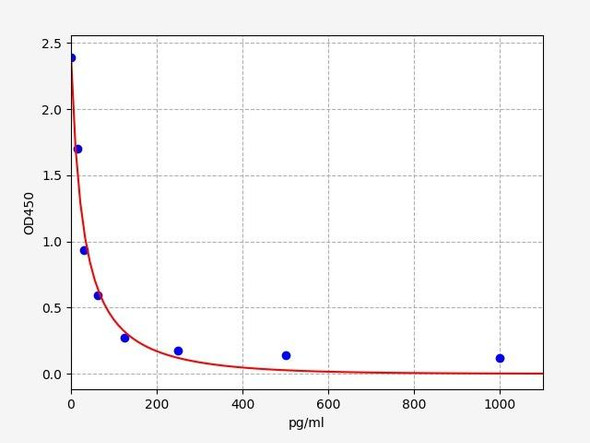Human Cell Biology ELISA Kits 1
Human OB (Obestatin) ELISA Kit (HUES02923)
- SKU:
- HUES02923
- Product Type:
- ELISA Kit
- Size:
- 96 Assays
- Uniprot:
- P41159
- Sensitivity:
- 0.47ng/mL
- Range:
- 0.78-50ng/mL
- ELISA Type:
- Competitive
- Reactivity:
- Human
- Sample Type:
- Serum, plasma and other biological fluids
- Research Area:
- Cell Biology
Description
| Assay type: | Competitive-ELISA |
| Format: | 96T |
| Assay time: | 2.5h |
| Reactivity: | Human |
| Detection Method: | Colormetric |
| Detection Range: | 0.78-50 ng/mL |
| Sensitivity: | 0.47 ng/mL |
| Sample Volume: | 50µL |
| Sample Type: | Serum, plasma and other biological fluids |
| Specificity: | This kit recognizes Human OB in samples. No significant cross-reactivity or interference between Human OB and analogues was observed. |
This ELISA kit uses Competitive-ELISA as the method. The microtiter plate provided in this kit has been pre-coated with Human OB. During the reaction, Human OB in the sample or standard competes with a fixed amount of Human OB on the solid phase supporter for sites on the Biotinylated Detection Ab specific to Human OB. Excess conjugate and unbound sample or standard are washed from the plate, and Avidin conjugated to Horseradish Peroxidase (HRP) are added to each microplate well and incubated. Then a TMB substrate solution is added to each well. The enzyme-substrate reaction is terminated by adding Stop Solution and the color change is measured spectrophotometrically at a wavelength of 450 nm ± 2 nm. The concentration of Human OB in the samples is then determined by comparing the OD of the samples to the standard curve.
| UniProt Protein Function: | leptin: May function as part of a signaling pathway that acts to regulate the size of the body fat depot. An increase in the level of LEP may act directly or indirectly on the CNS to inhibit food intake and/or regulate energy expenditure as part of a homeostatic mechanism to maintain constancy of the adipose mass. Defects in LEP may be a cause of obesity (OBESITY). It is a condition characterized by an increase of body weight beyond the limitation of skeletal and physical requirements, as the result of excessive accumulation of body fat. Belongs to the leptin family. |
| UniProt Protein Details: | Protein type:Secreted; Secreted, signal peptide; Hormone; Cell development/differentiation Chromosomal Location of Human Ortholog: 7q31. 3 Cellular Component: extracellular space; cytoplasm; extracellular region Molecular Function:peptide hormone receptor binding; growth factor activity; hormone activity Biological Process: circadian rhythm; response to dietary excess; positive regulation of myeloid cell differentiation; regulation of fat cell differentiation; regulation of steroid biosynthetic process; female pregnancy; negative regulation of transcription from RNA polymerase II promoter; glucose homeostasis; positive regulation of luteinizing hormone secretion; negative regulation of appetite; positive regulation of tyrosine phosphorylation of Stat3 protein; response to insulin stimulus; response to vitamin E; positive regulation of MAPKKK cascade; regulation of cholesterol absorption; regulation of blood pressure; positive regulation of cell proliferation; positive regulation of ion transport; central nervous system neuron development; placenta development; positive regulation of cytokine production; cholesterol metabolic process; positive regulation of developmental growth; bile acid metabolic process; eating behavior; glucose metabolic process; adult feeding behavior; ovulation from ovarian follicle; leptin-mediated signaling pathway; negative regulation of vasoconstriction; tyrosine phosphorylation of STAT protein; fatty acid beta-oxidation; insulin secretion; glycerol biosynthetic process; energy reserve metabolic process; response to hypoxia; hormone metabolic process; regulation of gluconeogenesis; positive regulation of follicle-stimulating hormone secretion; positive regulation of insulin receptor signaling pathway; leukocyte tethering or rolling; regulation of insulin secretion; negative regulation of apoptosis Disease: Leptin Deficiency |
| NCBI Summary: | This gene encodes a protein that is secreted by white adipocytes, and which plays a major role in the regulation of body weight. This protein, which acts through the leptin receptor, functions as part of a signaling pathway that can inhibit food intake and/or regulate energy expenditure to maintain constancy of the adipose mass. This protein also has several endocrine functions, and is involved in the regulation of immune and inflammatory responses, hematopoiesis, angiogenesis and wound healing. Mutations in this gene and/or its regulatory regions cause severe obesity, and morbid obesity with hypogonadism. This gene has also been linked to type 2 diabetes mellitus development. [provided by RefSeq, Jul 2008] |
| UniProt Code: | P41159 |
| NCBI GenInfo Identifier: | 730218 |
| NCBI Gene ID: | 3952 |
| NCBI Accession: | P41159. 1 |
| UniProt Secondary Accession: | P41159,O15158, Q56A88, |
| UniProt Related Accession: | P41159 |
| Molecular Weight: | 18,641 Da |
| NCBI Full Name: | Leptin |
| NCBI Synonym Full Names: | leptin |
| NCBI Official Symbol: | LEP |
| NCBI Official Synonym Symbols: | OB; OBS; LEPD |
| NCBI Protein Information: | leptin; obese protein; obesity factor; obese, mouse, homolog of; leptin (murine obesity homolog); leptin (obesity homolog, mouse) |
| UniProt Protein Name: | Leptin |
| UniProt Synonym Protein Names: | Obese protein; Obesity factor |
| Protein Family: | Leptin |
| UniProt Gene Name: | LEP |
| UniProt Entry Name: | LEP_HUMAN |
As the OD values of the standard curve may vary according to the conditions of the actual assay performance (e. g. operator, pipetting technique, washing technique or temperature effects), the operator should establish a standard curve for each test. Typical standard curve and data is provided below for reference only.
| Concentration(ng/mL) | O.D | Average |
| 50 | 0.422 0.424 | 0.423 |
| 25 | 0.532 0.556 | 0.544 |
| 12.5 | 0.776 0.74 | 0.758 |
| 6.25 | 1.077 1.111 | 1.094 |
| 3.13 | 1.534 1.516 | 1.525 |
| 1.56 | 1.974 1.952 | 1.963 |
| 0.78 | 2.308 2.308 | 2.308 |
| 0 | 2.781 2.795 | 2.788 |
Precision
Intra-assay Precision (Precision within an assay): 3 samples with low, mid range and high level Human OB were tested 20 times on one plate, respectively.
Inter-assay Precision (Precision between assays): 3 samples with low, mid range and high level Human OB were tested on 3 different plates, 20 replicates in each plate.
| Intra-assay Precision | Inter-assay Precision | |||||
| Sample | 1 | 2 | 3 | 1 | 2 | 3 |
| n | 20 | 20 | 20 | 20 | 20 | 20 |
| Mean (ng/mL) | 2.40 | 5.30 | 21.50 | 2.60 | 5.20 | 20.90 |
| Standard deviation | 0.20 | 0.30 | 0.90 | 0.20 | 0.20 | 0.80 |
| C V (%) | 8.33 | 5.66 | 4.19 | 7.69 | 3.85 | 3.83 |
Recovery
The recovery of Human OB spiked at three different levels in samples throughout the range of the assay was evaluated in various matrices.
| Sample Type | Range (%) | Average Recovery (%) |
| Serum (n=5) | 90-105 | 97 |
| EDTA plasma (n=5) | 91-106 | 98 |
| Cell culture media (n=5) | 88-102 | 94 |
Linearity
Samples were spiked with high concentrations of Human OB and diluted with Reference Standard & Sample Diluent to produce samples with values within the range of the assay.
| Serum (n=5) | EDTA plasma (n=5) | Cell culture media (n=5) | ||
| 1:2 | Range (%) | 84-98 | 97-112 | 90-104 |
| Average (%) | 90 | 105 | 95 | |
| 1:4 | Range (%) | 87-103 | 88-99 | 94-108 |
| Average (%) | 94 | 94 | 100 | |
| 1:8 | Range (%) | 85-97 | 91-105 | 96-114 |
| Average (%) | 91 | 99 | 104 | |
| 1:16 | Range (%) | 86-98 | 91-107 | 96-111 |
| Average (%) | 91 | 98 | 103 |
An unopened kit can be stored at 4°C for 1 month. If the kit is not used within 1 month, store the items separately according to the following conditions once the kit is received.
| Item | Specifications | Storage |
| Micro ELISA Plate(Dismountable) | 8 wells ×12 strips | -20°C, 6 months |
| Reference Standard | 2 vials | |
| Concentrated Biotinylated Detection Ab (100×) | 1 vial, 120 µL | |
| Concentrated HRP Conjugate (100×) | 1 vial, 120 µL | -20°C(shading light), 6 months |
| Reference Standard & Sample Diluent | 1 vial, 20 mL | 4°C, 6 months |
| Biotinylated Detection Ab Diluent | 1 vial, 14 mL | |
| HRP Conjugate Diluent | 1 vial, 14 mL | |
| Concentrated Wash Buffer (25×) | 1 vial, 30 mL | |
| Substrate Reagent | 1 vial, 10 mL | 4°C(shading light) |
| Stop Solution | 1 vial, 10 mL | 4°C |
| Plate Sealer | 5 pieces | |
| Product Description | 1 copy | |
| Certificate of Analysis | 1 copy |
- Set standard, test sample and control (zero) wells on the pre-coated plate and record their positions. It is recommended to measure each standard and sample in duplicate. Note: add all solutions to the bottom of the plate wells while avoiding contact with the well walls. Ensure solutions do not foam when adding to the wells.
- Add 50µL of Standard, Blank or Sample to their respective wells. The blank well is added with Sample / Standard dilution buffer.
- Immediately add 50 µL of Biotin-detection antibody working solution to each well.
- Cover with a plate seal and gently tap the plate to ensure thorough mixing. Incubate for 45minutes at 37°C.
- Aspirate or decant the solution from the plate and add 350µL of wash buffer to each welland incubate for 1-2 minutes at room temperature. Aspirate the solution from each well andclap the plate on absorbent filter paper to dry. Repeat this process 3 times. Note: a microplatewasher can be used in this step and other wash steps.
- Add 100µL of HRP Conjugate working solution to each well and over with a plate seal. Incubate for 30 minutes at 37°C.
- Repeat the aspiration/wash process 5 times according to step 5.
- Add 90µL of the Substrate reagent to each well and cover with a new plate seal. Incubatefor approximately 15 minutes at 37°C and protect from light. The reaction time can beshortened or extended according to the colour change, but not by more than 30 minutes. Whenapparent gradient appears in standard wells, terminate the reaction.
- Stop: Add 50µL of Stop Solution to each well (wells will develop a yellow color immediately). Note: Adding the stop solution should be done in the same order as the substrate solution.
- Determine the optical density (OD value) of each well immediately with a microplate readerset at 450 nm. In advance, preheat the instrument and set the testing parameters.






